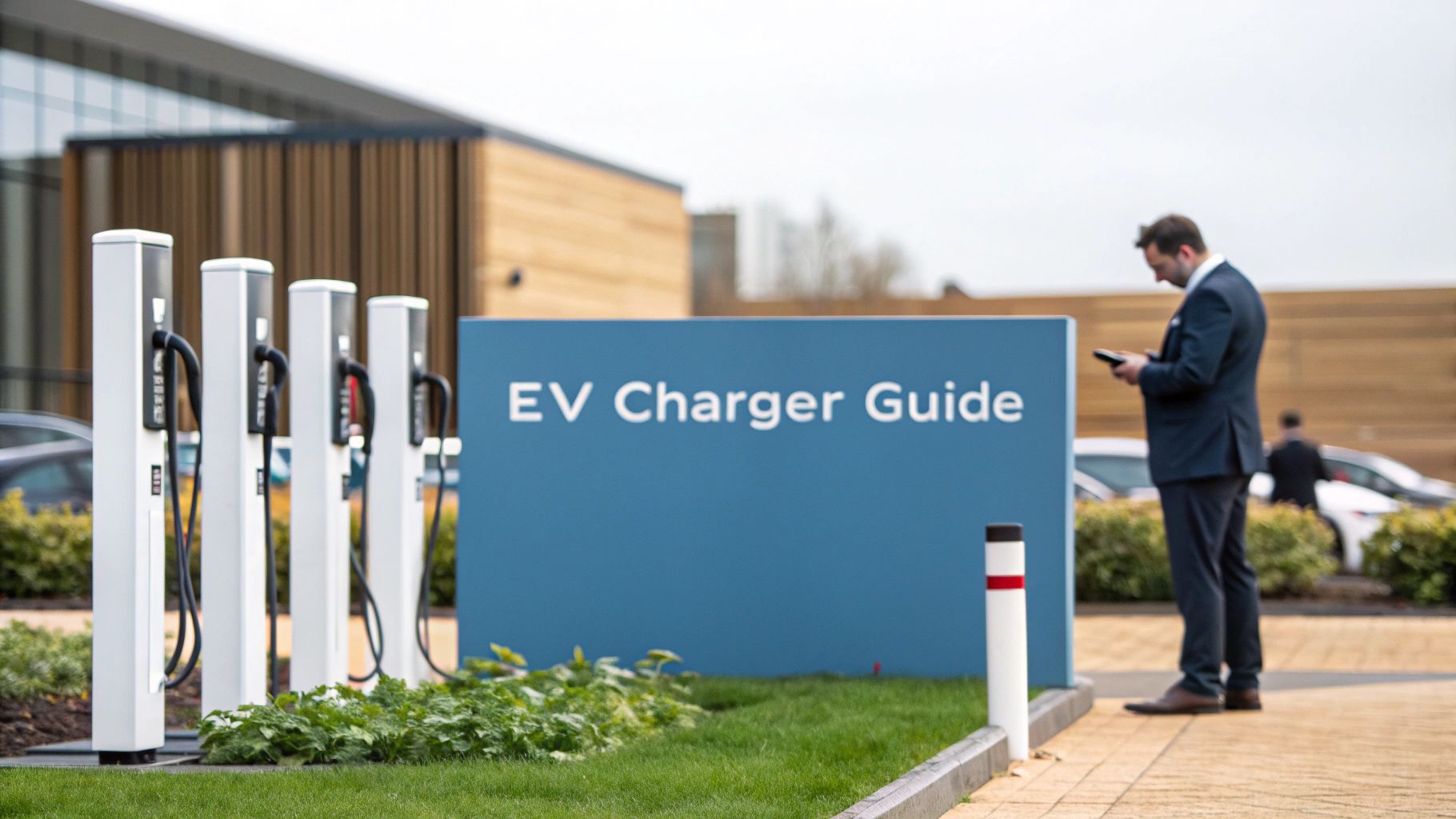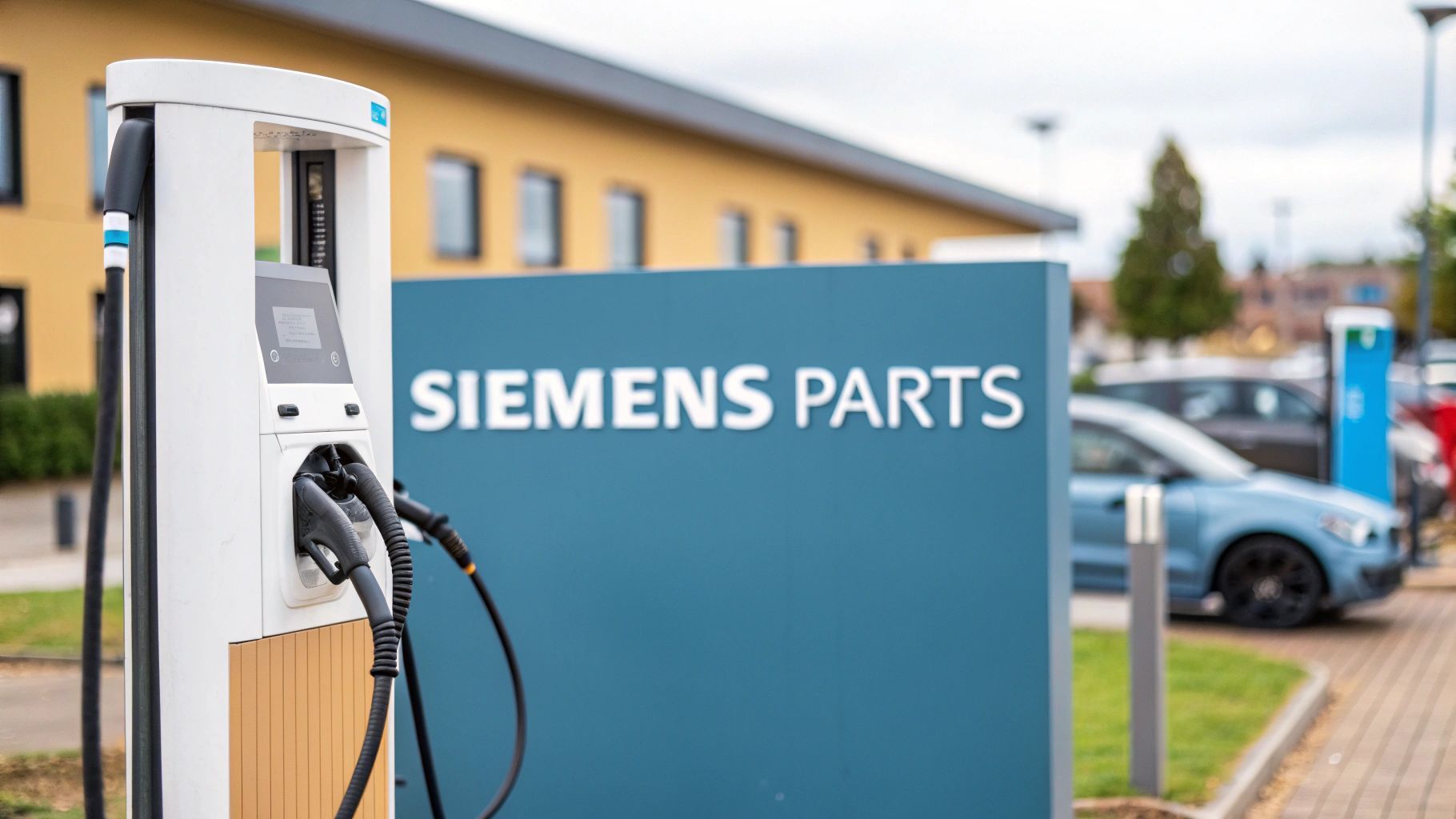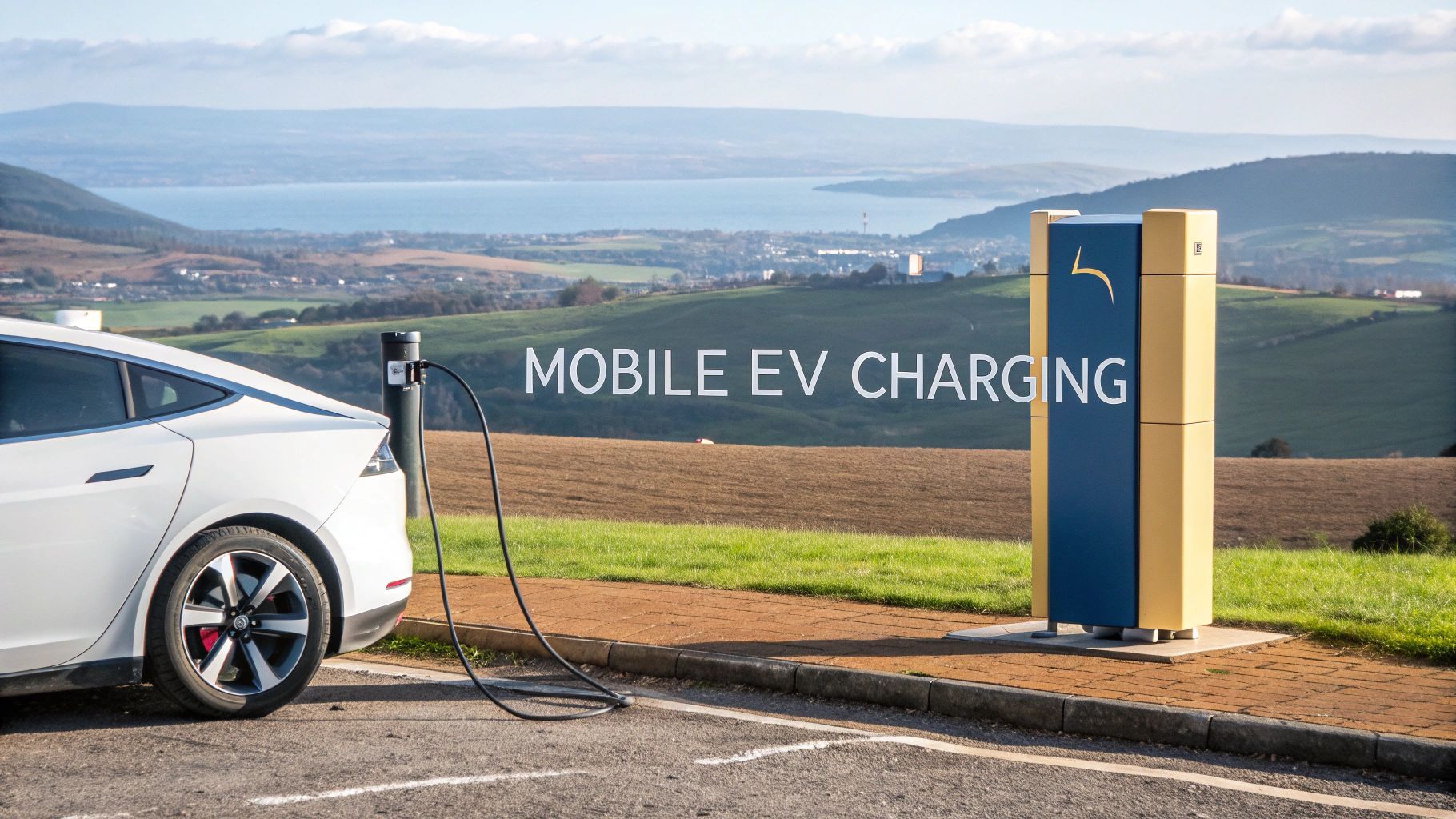Your guide to the plug type and EV charging in the Czech Republic
Heading to the Czech Republic? Let's get the essentials sorted for your electronics. You'll find the country uses the Type E electrical plug and socket , which is quite different from the rectangular Type G plug we're used to in the UK, so you will definitely need an adaptor. The good news? Your devices should work just fine, as both countries operate on a nearly identical voltage.
Understanding The Czech Republic Plug Type
When you’re packing for a trip to the Czech Republic, it’s crucial to know about the local electrical standards to keep your devices charged and safe. Forget the UK's familiar three-pronged plug; the plug type in the Czech Republic is the 'Type E' system, and it has a very distinct design.
The Czech Republic almost exclusively uses the Type E plug and socket system, often known as the 'French socket'. It’s easy to spot: the plug has two round pins and relies on a grounding pin that slots into a hole in the socket itself. This system is rated for 16 amps and is built for a voltage range between 220 and 240 volts at a 50 Hz frequency.
This choice sets the country apart from many of its neighbours in Continental Europe, who often use the Type F (Schuko) system instead.
Here’s a look at the distinct layout of the Type E plug on the left, compared to the more versatile hybrid Type E/F plug on the right, which is becoming increasingly common.

The main thing to notice is the central female earth socket, which is key to providing a secure grounding connection. If you’re interested in the nitty-gritty of how these connections work, this professional guide to the 3 pins connector is a great place to start.
For anyone travelling from the UK, the physical differences are the most important part. To make it crystal clear, here’s a quick comparison.
UK (Type G) vs Czech Republic (Type E) Plug Comparison
| Feature | UK Plug (Type G) | Czech Plug (Type E) |
|---|---|---|
| Pin Shape | 3 rectangular prongs | 2 round pins |
| Grounding | Separate, longer earth pin | Grounding hole in the socket |
| Fuse | Built-in fuse | No fuse in the plug |
| Compatibility | Not compatible with Type E | Not compatible with Type G |
As you can see, the two are fundamentally incompatible. A simple travel adaptor is all you’ll need to bridge the gap.
Key Electrical Standards
Beyond the physical shape of the plug, it’s also vital to get your head around the electrical specifications. Luckily, this part is simple.
- Voltage: The standard voltage is 230V , which is practically identical to the UK's 230V standard. This means most modern gadgets like laptops and phone chargers won't need a separate voltage converter. They are designed to handle it.
- Frequency: The standard frequency is 50 Hz , which is an exact match for the UK standard.
This alignment makes life much easier for UK visitors. Your main (and likely only) concern is the physical shape of the plug. While the Czech system is consistent across the country, standards can vary if you're planning a multi-country European trip. If Spain is on your itinerary, for example, our guide on the Spain converter plug has some useful tips.
Why You’ll Find Type E Plugs in the Czech Republic
Ever wondered why countries have different plug sockets? The choice of a specific plug in the Czech Republic wasn't an accident. It was a careful decision rooted in a blend of history, safety and a good dose of continental practicality. While neighbours went their own way, the Czech Republic aligned itself with the CEE 7/5 standard , which most of us simply know as Type E.
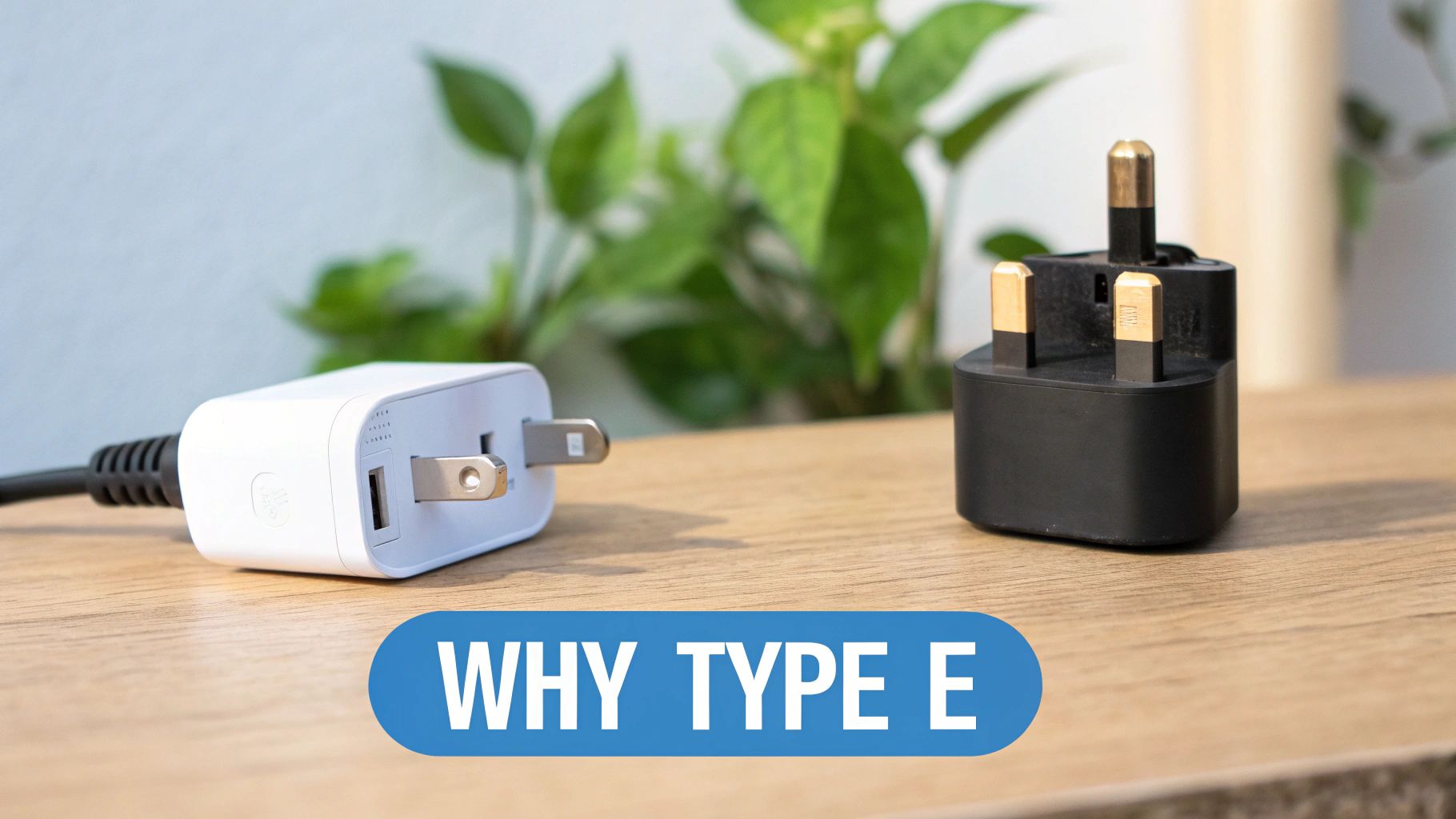
There was a time when the German Schuko (Type F) system was on the table but ultimately, the Czechs prioritised the unique grounding feature of the Type E socket. What makes it special is the male earth pin that sticks out from the socket itself. This smart design creates a secure grounding connection before the live pins even make contact, adding an extra layer of safety. You can dive deeper into this bit of electrical history over at the Plug Socket Museum.
This focus on a solid earth connection was a game-changer for protecting both people and their appliances.
Staying in Sync with Europe
Safety was one thing but pragmatism was another. By adopting a standard 230V/50Hz system alongside the Type E plug, the country ensured its electrical grid was perfectly compatible with a huge part of Europe, including France, Poland and Belgium. This move was crucial for making trade, travel and energy integration across the continent that much simpler.
The great thing about the 230V/50Hz standardisation is that for most modern gadgets, travellers only need to worry about the physical plug shape, not the voltage or frequency.
You'll also notice the humble 'Europlug' (Type C) everywhere. This simple two-pin plug is designed for smaller, low-power devices that don't need an earth connection, like your phone charger or electric shaver. It's brilliantly designed to fit snugly into the Type E sockets you'll find across the country, making life just that little bit easier for everyone.
Powering Your Electric Vehicle in the Czech Republic
Knowing about the standard plug type in the Czech Republic is one thing but powering an electric vehicle (EV) is a completely different challenge. You can technically use a standard Type E socket for a slow, overnight 'trickle' charge but this method is often impractical for anything more than a quick top-up. The real power for modern transport lies in dedicated EV charging infrastructure.
The national 230V grid is the backbone supporting a growing network of public chargers. For EV drivers, the key is knowing which connectors your vehicle needs. Fortunately, the Czech Republic sticks to EU-wide standards, which simplifies things considerably. This consistency is a massive relief compared to the world of domestic plugs, where adapters are a constant necessity. In fact, data shows around 95% of visitors from non-Type E countries rely on adaptors just for their personal devices. You can get a better sense of global plug compatibility over at power-plugs-sockets.com.
AC and DC Charging Standards
When you pull into a public charging station, you’ll mainly find two types of connectors waiting for you:
- Type 2 (Mennekes): This is the universal standard across Europe for AC charging. It’s what you'll use at most public destinations like supermarkets, hotels and car parks for regular charging speeds.
- Combined Charging System (CCS): For rapid EV charging on the go, the CCS connector is king. It cleverly combines the Type 2 AC connector with two large DC pins below it, allowing for high-power DC charging that can replenish a battery in minutes, not hours.
These systems are the crucial link between a simple wall outlet and the high-power demands of a long-distance EV journey.
The standardisation of Type 2 and CCS connectors across the EU means that whether you are in Prague or Paris, the public charging experience remains consistent. This removes a major barrier for international EV travel.
This network of chargers represents a critical piece of modern energy infrastructure. To learn more about the technology behind these stations, from simple home units to advanced rapid chargers, check out our detailed guide to electric vehicle supply equipment. Understanding the equipment is key to appreciating the entire EV ecosystem.
Solving EV Charging Challenges on a Constrained Grid
The explosion in electric vehicle ownership is putting real pressure on national power grids and the Czech Republic is right in the thick of it. Knowing the standard domestic plug type in the Czech Republic is one thing but figuring out how to manage the colossal power draw from thousands of EVs plugging in at once? That’s a far bigger puzzle than what a simple wall socket can solve.
This isn’t some far-off problem; it’s happening right now in areas where the grid is already stretched thin. To get ahead of it, the country is turning to smarter technologies like distributed energy resources to keep the lights on for everyone while supporting the shift to electric transport.
The infographic below breaks down the different places an EV driver might top up, from a slow overnight charge at home to the high-speed public stations you see at service stations.
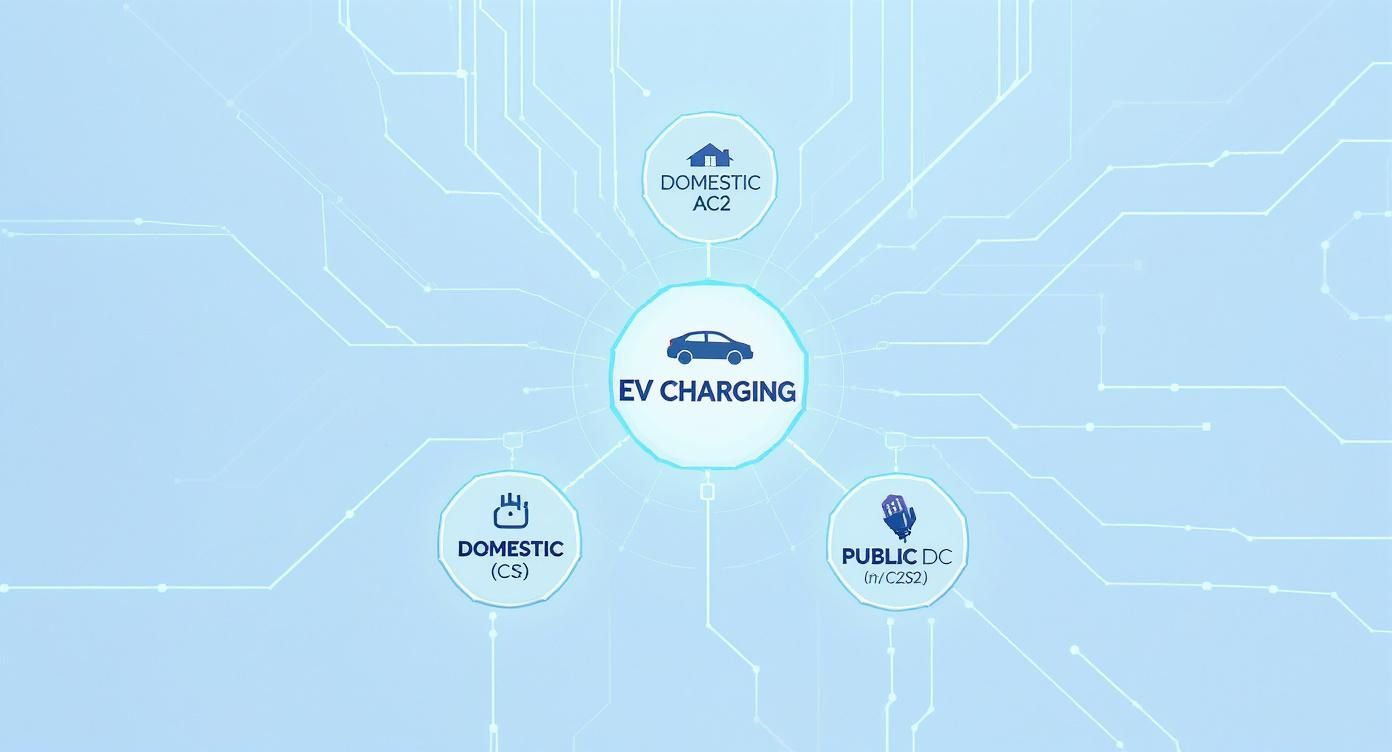
As you can see, each charging method pulls a different amount of power from the grid and needs its own specific type of connector to do the job.
Smart Charging and Mobile Solutions
One of the most powerful tools is smart charging . Think of it as traffic control for electricity. Instead of everyone charging their car the moment they get home from work – creating a massive energy rush hour – smart technology shifts the charging schedule to off-peak times. This is usually overnight, when overall demand is way down and electricity is cheaper.
By spreading out the demand, smart charging prevents those sudden spikes that can put the grid under serious strain.
Another incredibly useful innovation is mobile EV charging . These are essentially power banks on wheels and they’re perfect for a few key scenarios:
- Roadside Assistance: Giving a quick boost to an EV that’s run out of juice.
- Temporary Events: Powering up vehicles at festivals or exhibitions where permanent chargers just aren't practical.
- Fleet Operations: Providing flexible charging for commercial fleets without having to build out a huge fixed depot.
Mobile units are a game-changer because they separate the act of charging from a fixed spot on the map. They're the ultimate stopgap, delivering power exactly where and when it's needed without adding a permanent load to one specific point on the grid.
For locations with really tight grid connections, the answer often lies in creating a self-sufficient little ecosystem. Picture a charging hub with combined on-site renewables like solar panels and a large battery system. The panels soak up sun all day, storing that energy in the battery. Later, EVs can charge up using that stored power, barely touching the public grid at all.
This blend of renewables, EV charging and batteries and smart energy management is exactly how we build a charging network that’s robust enough for the future.
The table below provides a quick overview of different charging strategies and how they interact with the electrical grid.
EV Charging Methods and Their Grid Impact
| Charging Method | Typical Use Case | Grid Impact | Mitigation Strategy |
|---|---|---|---|
| Unmanaged Charging | Charging at home or work as soon as the vehicle is plugged in. | High. Can cause significant spikes in demand during peak hours (e.g., early evening). | Can lead to local transformer overload and grid instability if concentrated. |
| Smart Charging (V1G) | Scheduled charging during off-peak hours, often managed via an app. | Low. Flattens the demand curve by shifting load to times of low overall consumption. | Requires software and communication between the charger, vehicle and grid operator. |
| Mobile Charging | Roadside assistance, temporary event power or fleet charging. | Variable. Impact is temporary and localised to the unit's connection point. | Acts as a flexible resource, reducing the need for permanent grid upgrades in some areas. |
| On-site Generation & Storage | Charging hubs with integrated solar panels and battery systems. | Very Low. Can operate independently of the grid or even support it by exporting excess power. | High initial capital cost for renewables and battery infrastructure. |
Ultimately, a combination of these approaches will be needed to create a resilient and efficient EV charging infrastructure that can grow alongside the number of electric vehicles on the road.
How Grid Scale Batteries and Renewables Power the Future

That simple socket on your wall is just the final stop in a vast and increasingly intelligent energy network. While the standard plug type in the Czech Republic connects us to the grid, the real transformation is happening behind the scenes, where grid scale batteries and renewables are completely rewriting the rules.
This bigger picture is vital for supporting the massive energy demands of an electrified world, especially with the boom in rapid EV charging. The best way to think of a grid-scale battery is as a giant energy sponge.
On a bright, sunny day or when the wind is blowing hard, renewable sources often generate more electricity than the country needs. Instead of letting that precious green energy go to waste, it's soaked up and stored by huge battery installations.
Creating a Resilient and Smart Energy Ecosystem
These batteries then hold onto that power, waiting for the perfect moment to release it back into the grid. This usually happens during peak demand hours, like in the early evening when everyone gets home, flicks on the lights and plugs in their electric vehicles.
By releasing stored renewable energy when it’s needed most, these batteries act as a crucial buffer. They ensure a stable and reliable power supply even when the sun isn't shining or the wind isn't blowing. This is the very essence of a distributed energy system—a smart network of smaller, localised power sources all working in harmony.
This symbiotic relationship between renewables and storage creates a resilient, sustainable ecosystem. It allows electric mobility to be powered by genuinely green technology, not just electricity from traditional fossil fuel plants.
This intelligent balancing act is what keeps the grid from becoming overloaded during busy periods. It also makes sure we squeeze every last drop of value from the clean energy we generate. For those who want to dive deeper into the technical side, ZPN offers fantastic insights into integrating renewable energy with advanced storage solutions.
Combined on-site renewables and batteries are fast becoming a cornerstone of modern infrastructure. This approach not only supports the rise of EV charging from constrained grid connections but also paves the way for a cleaner, more efficient energy future for everyone.
Your Questions Answered: Plugs and EV Charging in the Czech Republic
Got questions about navigating the electrical and EV charging landscape in the Czech Republic? Here are some quick answers to the most common queries we hear.
Can I Use My UK Hair Dryer in the Czech Republic?
Yes, you can but you'll absolutely need a travel adaptor to fit the local sockets (specifically, a UK Type G to a European Type E). The good news is that both the UK and the Czech Republic run on a similar 230V standard, so you won’t need a bulky voltage converter for most modern gadgets.
Even so, it’s always a smart habit to double-check the label on your appliance. Make sure it’s rated for 220-240V before you plug it in, just to be safe.
Is the Type E Plug the Same as in France or Poland?
It certainly is. The plug type in the Czech Republic is the same Type E system you’ll find in France, Poland, Belgium and Slovakia. This standardisation makes life much easier, ensuring your adaptors and devices work seamlessly as you travel between these neighbouring countries.
How Do Public Rapid EV Chargers Get So Much Power?
This is a great question and it gets to the heart of what makes rapid EV charging possible. While your hotel room provides standard single-phase 230V power, public rapid EV chargers tap directly into the high-voltage, three-phase electrical grid.
This powerful connection is what allows them to deliver an immense amount of energy—anywhere from 50kW up to 350kW —straight to a vehicle's battery. By doing this, they bypass the car's much slower onboard converter, slashing charging times dramatically.
The ability to draw from the three-phase grid is fundamental to rapid EV charging. It highlights the shift from simple domestic power to sophisticated, grid-scale energy management needed for modern transport.
Do I Need a Special Adaptor for My EV in the Czech Republic?
For public chargers, no. The vast majority of AC chargers use the standard Type 2 connector, while rapid DC chargers use the CCS standard. If your vehicle was purchased in Europe, it will already be equipped with these ports.
The only time you'd need a domestic travel adaptor is if you plan to charge your EV slowly from a regular Type E wall socket, perhaps overnight at your accommodation.
For businesses and organisations looking to build the future of energy infrastructure, ZPN Energy offers leading solutions in rapid EV charging and battery storage. Discover how our technology can power your project at https://www.zpnenergy.com.


